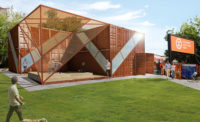Shigeru Ban Architects
Onagawa, Miyagi Prefecture, Japan
The residents of Shigeru Ban’s Container Temporary Housing in Onagawa used to call themselves the unluckiest people in town. For starters, the Miyagi Prefecture town of 10,000 was all but destroyed on March 11, when 3,800 of its 4,500 houses sustained significant damage or were demolished outright. Then they lost the lottery for temporary housing, leaving them no choice but to remain even longer in the town’s gymnasium-turned-evacuation-center. But after moving into Ban’s buildings, finished in November, this crowd feels it is the luckiest.
Though the end product proved to be worth the wait, Ban’s housing seemed to be a long time coming. “Any bureaucrat in any country is very careful and doesn’t want to take the risk of doing something new,” explains the Japanese architect. Building with shipping containers was uncharted territory for prefectural government officials, but it was Ban’s proposal for multistory structures that was the real sticking point. It took months to convince the authorities to deviate from their standard-issue, single-story solutions.
This time, however, single-story housing just wasn’t feasible. There simply was not enough flat land to accommodate all of Onagawa’s homeless. After months of Ban’s gentle persistence, the local officials eventually saw the light, and in August they gave the architect permission to start construction on the town baseball diamond.
In just three months, the housing was ready for occupancy. The project consists of nine separate buildings, supplying 189 residential units in six three-story and three two-story apartment blocks, with open public space in between for a tent-covered market and other communal functions. Each building block is a vertical checkerboard of containers secured by a steel frame. Private areas, such as sleeping quarters and bathrooms, are concentrated within the containers themselves, while the kitchen and dining areas occupy the enclosed, void spaces in between.
Because of its prefectural funding, the housing adheres strictly to the government’s rules regarding the size of each unit. “But we used the space very efficiently,” says Ban. “It is very well organized and includes built-in closets so it feels bigger than the standard temporary unit.”
Inside, members of the Voluntary Architects Network assembled shelving that allows for storage without compromising space. Furniture and appliances provided by the retailer MUJI also help. Outside, Ban erected two structures central to the dwellings: an atelier for the Onagawa government to host children’s art classes, and a community center, both built with paper tubes and shipping containers. A donated tent serves as an open-air market selling produce and other daily goods.
The residents are so satisfied with their interim accommodations that they have already expressed a desire to live here longer than the established two-year term. Yet Ban’s buildings come apart like Tinker Toys, so they are at the ready to be relocated and rebuilt when the next disaster strikes.
ARCHITECT: Shigeru Ban Architects.
BUDGET: N/A.
CONTEXT: Built in three months, Ban’s Container Temporary Housing consists of nine two- or three-story buildings spanned by 36-foot-wide slots of open space that serve as car parking and privacy buffers. They also create room for various communal functions.
People |
Products |









Post a comment to this article
Report Abusive Comment